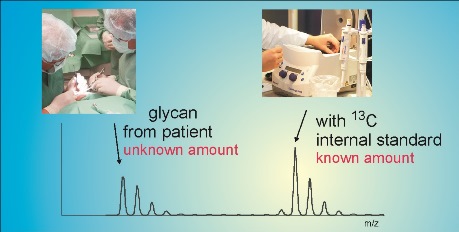Enzymatic isotope−labeling of O-glycans for improved tumor biomarker analysis
SUPERVISOR: FRIEDRICH ALTMANN
Background.
The analysis of O-glycosylated proteins is a hot topic in biopharmaceutical production. Furthermore has it become clear that several types of cancer cells (e.g. lung, ovarian, breast, colon, leukemia) exhibit an O-glycan profile that differs from normal tissue (Brockhausen et al., 2001, Ju et al., 2013, Storr et al., 2008). A well known alteration is the increased occurrence of relatively small oligosaccharides. The notorious Tn- and sialyl-Tn-antigens are protein-linked GalNAc and Neu5Ac-GalNAc mono- or disaccharides, respectively. The analysis of these very small compounds is difficult as they are not amenable to the otherwise highly efficient enrichment and purification procedure using porous graphitic carbon (PGC) cartridges. Furthermore, recoveries after chemical release (by hydrazine or by reductive β-elimination) are poor and varying. Released O-glycans may be analyzed after fluorescent labeling or - without label - by LC-MS, the latter constituting the current method of choice as it provides a much more detailed insight in the case of complex samples. If O-glycan biomarkers shall become useful for diagnosis, surgery follow-up or prediction of disease course, a reliable methodology for their analysis is indispensable. LC-MS methods will be either used directly or to calibrate other analysis tools. Researchers at the Vienna University Clinic of Urology (Dr. Christopher Taus, Dr. Michaela DeMartino) have manifested their interest to collaborate on this project.
Aims and methods.
The project wants to reach two goals: (1) the elaboration of a method that allows the unbiased quantitative analysis of the very small tumor-associated glycans Tn- and sialyl-Tn antigen. (2) Generation of internal reference substances that assure correct relative quantitation. These two efforts shall lead to an improved LC-MS based method for analysis of the O-glycan pattern from cultured cells, urine, saliva or possibly also biopsy samples.

Monosaccharides as well as neutral disaccharides do not adhere to a PGC surface well enough to allow their recovery after chemical release steps. The remedy proposed here is to elongate the cancer-typical stubs by recombinant glycosyltransferase(s) in order to make them large and thus adherent to PGC. The first and most relevant step will be the addition of β1,3-linked galactose by core 1β3-galactosyltransferase (C1β3Gal-T). This enzyme can be actively expressed in insect cells when its chaperone Cosmc is provided (Ju and Cummings, 2002). The hereby inserted residue will be stably isotope-labeled via UDP-13C-galactose, which we recently accomplished to generate (Thader, Maresch, Neumann, Altmann, manuscript in preparation). Since we still expect that this disaccharide will not yet be retained firmly by PGC, a second enzymatic elongation shall be performed with α2,3-sialyl-transferase (commercially available as well as recombinantly produced in our lab) and the donor sugar CMP-N-glycolylneuraminic acid (CMP-Neu5Gc). The latter will be prepared from Neu5Gc and CTP with the help of CMP-Sialic Acid Synthetase (QA-bio; Part number E-CMP01 or produced in-house).
An alternative approach could be to use CMP-Neu5Gc for directly labeling the Tn-antigen with the help of N-acetylgalactosamine-α2,6-sialyltransferase (ST6GalNAc I). By this approach, however, natural core I disaccharide will not be elongated and hence may get lost between release and analysis. As Neu5Gc is not a constituent of human glycans, the 16-Da mass difference differentiates the elongated from the natural version – in both strategies. The well-proven separation of the thus labeled and marked O-glycans will be performed by the established isomer-specific technique of PGC-LC with MS/MS detect ion and analysis (Jensen et al., 2012).
For interlab comparison of results, reference glycans with yet other mass increments are accessible via C1-reduction and re-N-acetylation.
Brockhausen, I., Yang, J., Lehotay, M., Ogata, S., Itzkowitz, S. (2001) Pathways of mucin O-glycosylation in normal and malignant rat colonic epithelial cells reveal a mechanism for cancer-associated Sialyl-Tn antigen expression. Biol. Chem. 382, 219-232
Jensen, P.H., Karlsson, N.G., Kolarich, D., Packer, N.H. (2012) Structural analysis of N- and O-glycans released from glycoproteins. Nat. Protoc. 7, 1299-1310
Ju, T., Cummings, R.D. (2002) A unique molecular chaperone Cosmc required for activity of the mammalian core 1β3-galactosyltransferase. Proc. Natl. Acad. Sci. USA 99, 16613-16618
Ju, T., Wang, Y., Aryal, R.P., Lehoux, S.D., Ding, X., Kudelka, M.R., Cutler, C., Zeng, J., Wang, J., Sun, X., Heimburg-Molinaro, J., Smith, D.F., Cummings, R.D. (2013) Tn and sialyl-Tn antigens, aberrant O-glycomics as human disease markers. Proteomics Clin. Appl. 7, 618–631
Storr, S.J., Royle, L., Chapman, C.J., Hamid, U.M., Robertson, J.F., Murray, A., Dwek, R.A., Rudd, P.M. (2008) The O-linked glycosylation of secretory/shed MUC1 from an advanced breast cancer patient's serum. Glycobiology 18, 456-462
